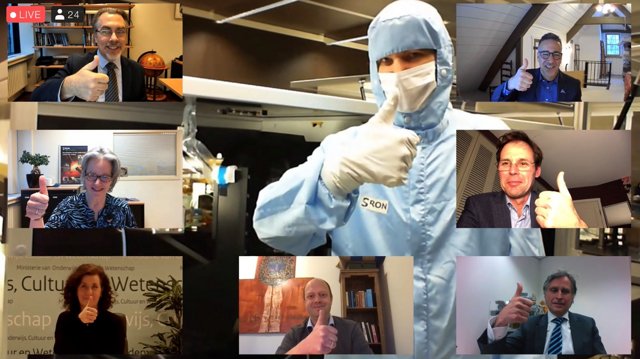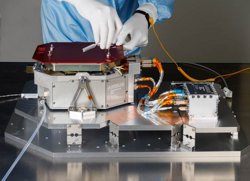Dutch Minister Van Engelshoven: “SPEXone is good to go!”
Yesterday, space research institute SRON briefly opened its digital doors for the media and the parties that have been collaborating over the past years on the new Dutch satellite instrument SPEXone. On behalf of the Dutch government, outgoing minister Ingrid van Engelshoven of the Ministry of Education, Culture and Science was there to conduct a final inspection of the instrument before it is shipped off to NASA in the United States.
The online presentation switched from SRON in Utrecht via the NSO in The Hague to the Goddard Space Flight Center in the American state of Maryland and then back to SRON, where SPEXone spent the last few months undergoing a rigorous battery of tests in the cleanroom in preparation of its launch and the start of its mission. Viewers were left with two impressions: the collaboration between the Netherlands and NASA could not be more effective and SPEXone is sure to make an impact in the field of climate science.

The effects of aerosols
Starting in 2023, NASA's PACE satellite will be studying the complex interplay between our planet's oceans, the atmosphere and the climate. The Dutch instrument SPEXone will focus on the effects of aerosols; small dust particles in Earth's atmosphere.There is much we do not know about aerosols. This general lack of knowledge has major consequences for the reliability of climate models.
Karen St. Germain, Earth Science Division director at NASA, eagerly awaits the arrival of SPEXone at NASA's Goddard Space Flight Center. “This is the result of an important partnership between NASA and the Netherlands. I am very happy with SRON, the NSO and all other parties in the Netherlands who helped make this possible.”
The Netherlands and NASA have a long history of collaboration, says NSO director Harm van de Wetering. Previously, a Dutch consortium developed the OMI instrument for NASA's Aura satellite. This instrument played a key role in research of the expansion and contraction of the hole in the ozone layer. OMI was launched in 2004 and continues to operate flawlessly to this day.
Van de Wetering is confident that SPEXone will be another big success for the field of climate science and for the Netherlands: “SPEXone has great scientific and social relevance. The development of this instrument ties into the economic goals of the Dutch space industry. I am proud of what we have achieved here and I certainly don't think this will mark the end of our partnership.”

Faith in the instrument
Aaldert van Amerongen, head of SRON's earth observation programme, gave viewers access to SPEXone in the cleanroom via a video connection. Together with three of his engineers, all wearing dust coats and facial protection, he talked about the results of an extensive testing campaign conducted over the past few months: “We have collected a wealth of high-quality data, which will allow us to make optimal use of the instrument once it reaches outer space and begins studying aerosols. The test results give us every reason to believe that the instrument is ready to go.”
Minister Van Engelshoven directed one final look at the instrument and the strong titanium legs with which it will be attached to the PACE satellite. “I am impressed by the perseverance of all parties watching today. Everyone has worked on this instrument with so much passion and expertise that there is only one possible conclusion I can draw after this unique final inspection: SPEXone is good to go.”
About SPEXone
SPEXone is a compact, optical satellite instrument that will characterize aerosols from a low orbit around the Earth. It is part of the NASA's PACE satellite (launch 2023). SPEXone is being developed by a Dutch consortium consisting of the space research institute SRON and Airbus Defense and Space Netherlands, supported by opto-mechanical experts from TNO. SRON and Airbus DS NL are responsible for the design, assembly and testing of the instrument. Scientific leadership is in the hands of SRON. SPEXone is a public-private initiative made possible by NSO with resources made available by OCW and by SRON-NWO with support from Airbus DS NL.